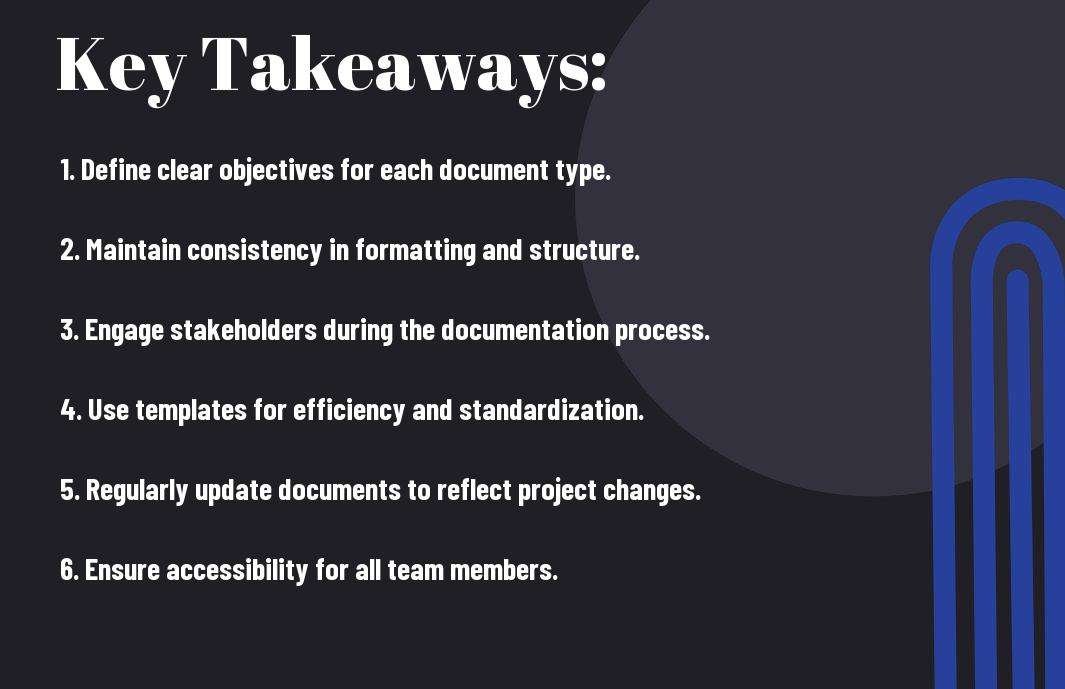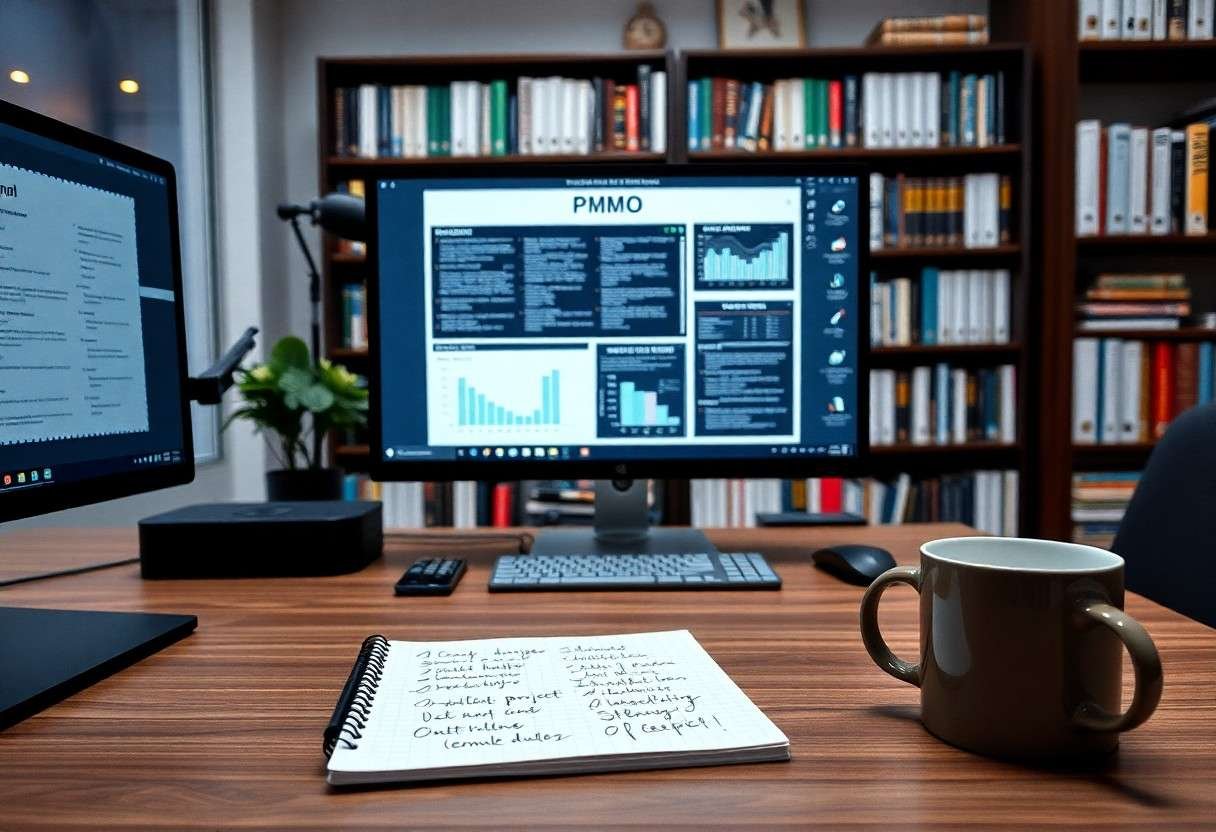PMO documentation serves as the backbone of project management, ensuring that you have a clear framework to guide your initiatives. In my experience, following best practices not only enhances communication but also significantly improves project outcomes. I will provide you with imperative insights into what you should consider while creating documentation that is not only comprehensive but also user-friendly. By adopting these practices, you can safeguard against miscommunication and elevate the effectiveness of your PMO.

Key Takeaways:
- Clarity and Consistency: Ensure that all documentation is clear, well-structured, and uses consistent terminology throughout to facilitate understanding across teams.
- Stakeholder Engagement: Actively involve stakeholders in the documentation process to ensure it meets their needs and expectations, fostering better collaboration and buy-in.
- Regular Reviews and Updates: Schedule regular reviews of documentation to keep it up-to-date and relevant, reflecting any changes in processes or project requirements.

Importance of PMO Documentation
A well-structured PMO documentation framework is fundamental for project success. It ensures that processes are standardized, and provides a valuable reference for current and future projects. Consistent documentation enhances communication and aligns team expectations. For further insights, I recommend exploring Project Management Offices and PMO Best Practices…
Enhancing Project Clarity
Enhancing project clarity is a significant benefit of thorough PMO documentation. Clear and detailed documents lay a solid foundation for understanding project scope, objectives, roles, and timelines, which ultimately leads to smoother execution.
Facilitating Stakeholder Engagement
Along with clarity, effective PMO documentation plays a vital role in facilitating stakeholder engagement. Engaging stakeholders through well-prepared records not only ensures their alignment with the project’s vision but also fosters accountability and transparency.
It is important to actively involve stakeholders using comprehensive documentation that addresses their concerns and expectations. By doing so, you promote a sense of ownership and responsibility among all parties. This approach can significantly mitigate risks by reducing misunderstandings, thereby enhancing collaboration. Providing stakeholders with access to relevant documentation ensures they remain informed, encouraging their input and investment in project success.
Key Types of PMO Documentation
Now, understanding the key types of PMO Documentation is vital for effective project management. Here are the fundamental documents:
| Project Charters | Outline of project objectives and stakeholders. |
| Status Reports | Current progress and issues of projects. |
| Risk Management Plans | Strategies for identifying and mitigating risks. |
| Meeting Minutes | Records of discussions and action items. |
| Project Schedules | Timelines for project phases and deliverables. |
Thou shall ensure that these documents are consistently updated to reflect the current state of projects.
Project Charters
The Project Charter serves as the foundational document for your project, establishing its purpose, objectives, and stakeholders. It is vital for aligning all parties involved, ensuring everyone has a clear understanding of the project’s goals from the outset.
Status Reports
Against the backdrop of ongoing project execution, Status Reports provide a snapshot of project progress, resource allocation, and any outstanding issues that may impact outcomes. These documents foster transparency and accountability among project team members.
Further, regular Status Reports allow for timely adjustments and interventions, thereby enhancing overall project performance. By tracking key performance indicators, I can easily determine if the project is on track or if resources need to be reallocated.
Risk Management Plans
Against the unpredictable nature of projects, a Risk Management Plan outlines potential risks and strategies to mitigate them. This document ensures you’re prepared for challenges that could derail your project.
Also, a comprehensive Risk Management Plan not only identifies threats but also emphasizes opportunities for improving project performance. By understanding risks in advance, you can implement proactive measures that safeguard against adverse impacts, leading to more successful project outcomes.
Best Practices for Document Creation
After defining your PMO objectives, it’s imperative to follow systematic approaches to document creation. I suggest you adhere to How to Develop PMO Standards and Best Practices to streamline your documentation process. Approaching each document with standardized formats ensures consistency, fosters collaboration, and enhances clarity within the team.
Standardization
With a defined template for your documents, I find that it becomes easier to maintain consistency across all PMO documentation. Standardization not only improves readability but also ensures that everyone understands the format and flow of information, which ultimately leads to better project outcomes.
Accessibility and Usability
Between the numerous stakeholders involved in PMO activities, ensuring that documentation is easily accessible and user-friendly is paramount. I recommend that you utilize cloud-based platforms and intuitive navigation tools, which allow team members to find the information they need quickly.
This approach significantly enhances your team’s efficiency and collaboration. By prioritizing accessibility and usability, you empower your project members to engage with the documentation actively, leading to improved understanding and better alignment on project goals.
Version Control
At every stage of project execution, it is vital to implement a robust version control system for your documents. This means you will always work from the latest and most accurate information available.
And if you overlook version control, it can lead to the potential for miscommunication and errors. Implementing a version control strategy ensures that all team members are on the same page, thereby reducing risks and increasing the effectiveness of your project management efforts.
Tools and Software for Documentation
Despite the wide array of options available, selecting the right tools and software for documentation is vital to ensure that your PMO can maintain structure and clarity. Leveraging effective software solutions will not only streamline your documentation process but also improve collaboration, tracking, and efficiency within your team.
Project Management Tools
Around the landscape of PMO documentation, you will find various project management tools that can help organize, prioritize, and maintain your documentation. Tools like Asana, Trello, or Microsoft Project facilitate task management and allow you to link relevant documents directly to specific projects for easy reference.
Collaborative Platforms
Above all, using collaborative platforms like Microsoft Teams, Slack, or Google Workspace can significantly enhance your documentation process. These platforms enable real-time collaboration and sharing of documents, ensuring that your team remains aligned and informed throughout the project lifecycle.
Due to the nature of collaborative platforms, you can benefit from enhanced communication, streamlined document sharing, and integrated workflows. These tools help prevent information silos and allow team members to contribute insights rapidly, promoting a culture of transparency and engagement. Utilizing these platforms effectively will not only improve the quality of your documentation but also foster stronger relationships within your project teams.
Maintaining and Updating Documentation
Unlike static documents, your PMO documentation must be dynamic and adaptable. It’s vital to regularly maintain and update your documentation to reflect changes in your projects, methodologies, or organizational structure. This ongoing process guarantees that your PMO documentation remains relevant, providing accurate guidance and resources for your team.
Regular Reviews
Reviews of your PMO documentation should be scheduled at consistent intervals. This practice enables you to identify outdated information and rectify any discrepancies. By engaging with your documentation regularly, you reinforce its integrity and ensure that all team members have access to accurate resources.
Stakeholder Feedback
Feedback from stakeholders plays a vital role in the effectiveness of your PMO documentation. Regularly soliciting input can illuminate areas for improvement, ensuring your documents meet the needs of the team. By incorporating perspectives from users, you actively enhance the utility and impact of your PMO resources.
A well-structured feedback process not only identifies weaknesses in your documentation but also uncovers strengths you might have overlooked. Engaging stakeholders creates a sense of ownership over the documentation, leading to more thorough and committed contributions. By prioritizing input from diverse team members, you’re more likely to produce a resource that addresses various needs, ultimately fostering a more aligned and effective project management environment.
Common Pitfalls to Avoid
All organizations face challenges when creating PMO documentation. By understanding these pitfalls, you can streamline your efforts and enhance the effectiveness of your documents. Avoiding over-documentation, inconsistent formats, and a lack of stakeholder involvement can lead to a more efficient and impactful PMO.
Over-Documentation
Between excessive detail and redundant processes, over-documentation can bog down your PMO. I recommend focusing on what’s necessary to convey your message clearly. Aim to provide just enough information to maintain clarity while ensuring your documentation remains accessible and relevant to your audience.
Inconsistent Formats
Any documentation that varies in format can create confusion and hinder understanding. When I create PMO documentation, I emphasize the importance of consistency in layouts, fonts, and styles. This uniformity not only enhances readability but also builds a professional image and improves collaboration across teams.
In addition, maintaining consistent formats across your PMO documentation helps to establish a standardized approach. If your documents look and feel different, it can lead to miscommunication and misunderstandings among stakeholders. By implementing templates and style guidelines, you can promote cohesion, making it easier for team members to engage and find information swiftly. Consistency not only reinforces your credibility but also saves time in the long run, allowing you to concentrate on delivering value to your projects.
Final Words
Presently, I emphasize the importance of adopting best practices for creating crucial PMO documentation. By establishing clear guidelines, utilizing templates, and maintaining consistency in your documentation approach, you will ensure that your PMO operates effectively. Regular reviews and updates to your documents will keep them relevant, while involving stakeholders in the process fosters collaboration and transparency. Ultimately, I encourage you to prioritize these practices to enhance communication and drive project success within your organization.
FAQ
Q: What are the key components of effective PMO documentation?
A: Effective PMO documentation typically includes the project charter, project plan, stakeholder analysis, risk management plan, and status reports. The project charter outlines the objectives, scope, and stakeholders involved, while the project plan details the timeline, resources, and tasks necessary to achieve the project goals. A stakeholder analysis identifies the individuals and groups that have an interest in the project, helping to ensure effective communication. The risk management plan outlines potential risks and mitigation strategies to minimize their impact. Finally, status reports provide ongoing updates on project progress, helping stakeholders stay informed.
Q: How can you ensure consistency in PMO documentation across a project?
A: To ensure consistency in PMO documentation, it is vital to establish and follow standardized templates for all documentation. Create a documentation manual that outlines the expectations for layout, style, and content for each type of document. Regular training sessions can also help team members understand the importance of adhering to these standards. Furthermore, utilizing document management software can assist in maintaining version control and accessibility, allowing everyone involved in the project to work from the most current documents.
Q: What role does stakeholder engagement play in PMO documentation?
A: Stakeholder engagement is necessary in PMO documentation as it facilitates collaboration and ensures that all perspectives are considered. Engaging stakeholders in the documentation process helps identify their needs and expectations, which can be reflected in project documents. Regular feedback sessions can help gather input on key documents, such as the project plan and risk management strategies, ensuring that they are aligned with stakeholder expectations. This engagement also fosters transparency and encourages commitment from stakeholders, which can lead to better project outcomes.







